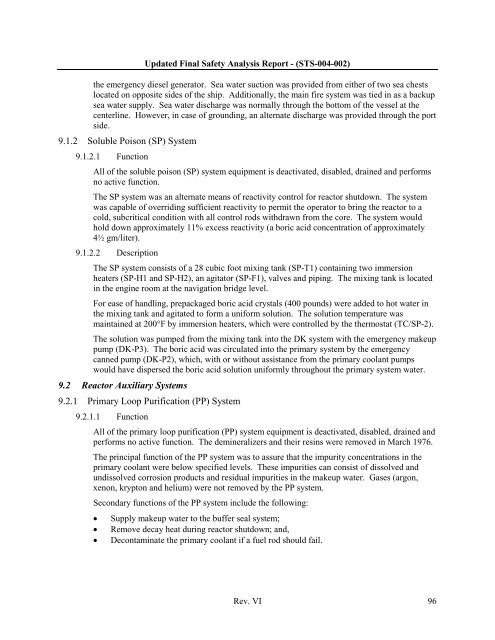Updated Final Safety Analysis Report - (STS-004-002)the emergency diesel generator. Sea water suction was provided from either <strong>of</strong> two sea chestslocated on opposite sides <strong>of</strong> the ship. Additionally, the main fire system was tied in as a backupsea water supply. Sea water discharge was normally through the bottom <strong>of</strong> the vessel at thecenterline. However, in case <strong>of</strong> grounding, an alternate discharge was provided through the portside.9.1.2 Soluble Poison (SP) System9.1.2.1 FunctionAll <strong>of</strong> the soluble poison (SP) system equipment is deactivated, disabled, drained and performsno active function.The SP system was an alternate means <strong>of</strong> reactivity control for reactor shutdown. The systemwas capable <strong>of</strong> overriding sufficient reactivity to permit the operator to bring the reactor to acold, subcritical condition with all control rods withdrawn from the core. The system wouldhold down approximately 11% excess reactivity (a boric acid concentration <strong>of</strong> approximately4½ gm/liter).9.1.2.2 DescriptionThe SP system consists <strong>of</strong> a 28 cubic foot mixing tank (SP-T1) containing two immersionheaters (SP-H1 and SP-H2), an agitator (SP-F1), valves and piping. The mixing tank is locatedin the engine room at the navigation bridge level.For ease <strong>of</strong> handling, prepackaged boric acid crystals (400 pounds) were added to hot water inthe mixing tank and agitated to form a uniform solution. The solution temperature wasmaintained at 200°F by immersion heaters, which were controlled by the thermostat (TC/SP-2).The solution was pumped from the mixing tank into the DK system with the emergency makeuppump (DK-P3). The boric acid was circulated into the primary system by the emergencycanned pump (DK-P2), which, with or without assistance from the primary coolant pumpswould have dispersed the boric acid solution uniformly throughout the primary system water.9.2 Reactor Auxiliary Systems9.2.1 Primary Loop Purification (PP) System9.2.1.1 FunctionAll <strong>of</strong> the primary loop purification (PP) system equipment is deactivated, disabled, drained andperforms no active function. The demineralizers and their resins were removed in March 1976.The principal function <strong>of</strong> the PP system was to assure that the impurity concentrations in theprimary coolant were below specified levels. These impurities can consist <strong>of</strong> dissolved andundissolved corrosion products and residual impurities in the makeup water. Gases (argon,xenon, krypton and helium) were not removed by the PP system.Secondary functions <strong>of</strong> the PP system include the following:Supply makeup water to the buffer seal system;Remove decay heat during reactor shutdown; and,Decontaminate the primary coolant if a fuel rod should fail.Rev. VI 96
9.2.1.2 DescriptionUpdated Final Safety Analysis Report - (STS-004-002)The PP system consisted <strong>of</strong> four letdown coolers - three demineralizers; two filters; andassociated instrumentation, controls, valves and piping.The four letdown coolers (PP-C1, PP-C2, PP-C3 and PP-C4) are identical shell and tube heatexchangers arranged in two parallel loops, each loop containing two letdown coolers in series.Cooling water for the letdown coolers was supplied by the intermediate cooling water system.Isolation valves (PP-1V, PP-2V, PP-3V and PP-4V) are located upstream and downstream <strong>of</strong>each pair <strong>of</strong> coolers and were operated by pushbuttons from the main control room. The valvearrangement permitted operation with either pair <strong>of</strong> coolers.The carbon steel shell <strong>of</strong> each cooler is about 30 inches in diameter and about 21 inches long.The tube side, in which primary water circulates, was designed for 2000 psig and 650°F. Theshell <strong>of</strong> each cooler was designed for 150 psig and 225°F. The coolers are located inside thecontainment vessel.During normal reactor operation, primary water at approximately 521°F and 1750 psia wasdrawn from the reactor outlet line <strong>of</strong> the port primary coolant loop. This water flowed throughthe letdown coolers and the normal flow control valves (PP-7V or PP-8V) to reduce thetemperature and pressure to about 1<strong>10</strong>°F and 50 psig.The flow control network, located downstream <strong>of</strong> the letdown coolers and inside thecontainment vessel, consists <strong>of</strong> the two normal flow control valves PP-7V and PP-8V) and abypass control valve (PP-6V). Valves PP-7V and PP-8V are diaphragm operated angle valvesand were used to control the system flow when the primary system pressure was above 500psig. At primary system pressure less than 500 psig, the bypass control valve (PP-6V), adiaphragm operated, straight-through valve, provided flow.Downstream <strong>of</strong> the flow control valves, the PP system piping penetrates the containment vesselbulkhead and enters the lower reactor compartment. A diaphragm operated valve (PP-57V) waslocated in this line immediately outside the containment vessel. This valve was operated by thecontainment isolation system. A flow measurement nozzle is located in the line downstream <strong>of</strong>valve PP-57V. A pressure detector (PIA/PP-6) and two temperature detectors (TICA/PP-4) arelocated in the same general area as the flow nozzle.The mixed-bed demineralizers (PP-E1, PP-E2 and PP-E3) were in the forward area <strong>of</strong> the lowerreactor compartment. They were removed in March 1976. Each unit was capable <strong>of</strong> handling aflow up to 30 gpm; therefore, with a normal system flow <strong>of</strong> 20 gpm, only one demineralizer wasin operation. Flows above 30 gpm required two units. The demineralizers were uprightcylindrical tanks, 30-inch ID and 5-foot high, with hemispherical heads. Each demineralizerwas surrounded with 4½ inches <strong>of</strong> lead shielding. Venting and draining operations associatedwith demineralizer units were made with a vent line connected to the gas manifold in thegaseous waste disposal (WL) system and with a drain line connected to the equipment drain andwaste collection (PD) system. Remotely operated isolation valves (PP-11V, PP-12V, PP-13V,PP-26V, PP-27V and PP-28V) are located on the upstream and downstream sides <strong>of</strong> eachdemineralizer. These valves were operated by pushbuttons from the main control room.The effluent filters (PP-E4 and PP-E5) are located at the outlet <strong>of</strong> the demineralizers in theforward port area <strong>of</strong> the lower reactor compartment. These units are identical in design andwere capable <strong>of</strong> removing resin fines and insoluble impurities from the demineralizer effluent.Each unit was capable <strong>of</strong> handling flows up to 30 gpm; therefore, at the normal flow <strong>of</strong> 20 gpm,only one unit was used. Each filter is about 12 inches in diameter and 32 inches long and isRev. VI 97
















